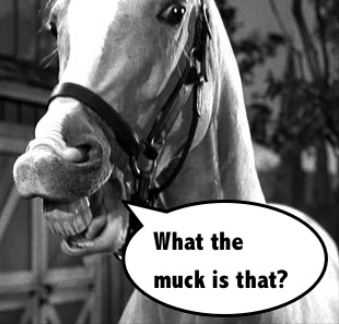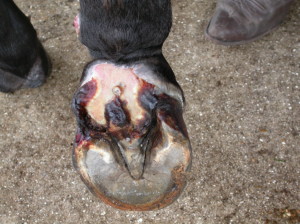#whatthemuck
What The Muck Is That? Squamous Cell Carcinoma
Amanda Uechi Ronan details this common skin tumor, and Kristen Kovatch shares her firsthand experience in treating this equine disease.
What The Muck Is That? Eponychium
Also known as “golden slippers” or “fairy fingers.”
(more…)
What The Muck Is That? Reader Edition: Bovine Lumpy Jaw
Amanda Smith shares her story!
(more…)
What The Muck Is That? Equine Grass Sickness & Alzheimer’s
Findings from a study have proven horses with the rare nerve condition have similar signs of disease as people with Alzheimer’s.
What The Muck Is That? ‘Eeyore’ Ears
Nope, no Photoshop here … just an unusual defect.
(more…)
What the Muck Is That? Overgrown Hooves
This week we take a look at overgrown hooves and how they got that way after a recent abuse case made headlines.
(more…)
‘Equine Cancer Vaccine Is Working’
… and could lead to human clinical trials.
(more…)
What The Muck Is That? Wry Nose
Amanda Uechi Ronan, #HorseNerd, details wry nose in this week’s “What the Muck Is That?”
(more…)
3 Most Common Skin Diseases of Spring
Spring is in the air, but with the warmer weather comes insect infestations and lots of itching. Let’s check out the top 3 culprits for spring skin diseases. (more…)
Fatal Disease Glanders Found at Texas Border
A Mexican stray donkey has tested positive for Glanders according to the Texas Animal Health Commission.
My Horse Is Growing Mane Hair From Its Leg. What Now?
What happens when a routine veterinary procedure gets, well, a little hairy? Check out this hilarious story from Dr. Bo Brock of Lamesa, Texas. (more…)
What the Muck Is That? Winter Skin Diseases
Prepare for phantom itching.
What The Muck Is That? ‘Swamp Cancer’
Each week we investigate one equestrian conundrum in “What the muck is that?” This week we take a look at Equine Pythiosis a.k.a. “Swamp Cancer.”
(more…)
What the Muck Is That? ‘Keratoma’
Each week we investigate one equestrian conundrum in “What the muck is that?” This week we take a look at keratomas by reader request.
What The Muck Is That? ‘Canker’
Each week we investigate one equestrian conundrum in “What the muck is that?” This week we take a look at Canker by reader request.
We recently received this message from a reader:
So… what the muck is that?
Canker is an infection that results in chronic hypertrophy (over growth or enlargement) of the horn-producing tissues in the hoof. It normally starts in the frog, but can quickly take over the sole, bars, and hoof wall. Canker can be in just one hoof or all four. Any breed, gender, or age of horse is susceptible to the disease, which has no known cause.
Is it like thrush?
Canker is very often misdiagnosed as thrush in its early stages. Thrush is a bacterial infection generally due to unsanitary living conditions or a very wet environment. Canker, on the other hand, is an infection of no known origin (some believe it is caused by the papillomavirus) that can be found in both wet and dry environments and on meticulously cared for equines.
Key Differences:
Thrush = Generally restricted to the clefts of the frog, central sulci, or puncture wounds.
Canker = Invades the horn of the frog anywhere throughout the structure.
Thrush = Damaged tissue turns dark black.
Canker = Damaged tissue turns a pale white or yellow.
Thrush = Loss of tissue.
Canker = Rapid increase of tissue.
What should I look for?
In the early stages you will see a light brown, grey or yellow tissue in the frog that bleeds easily and is painful to the touch. The horse may or may not be lame.
If left untreated the canker will spread rapidly, resulting in a “cauliflower-like” appearance and mild to severe lameness.
Check out this video that shows a farrier’s reaction to canker.
What’s the treatment?
Veterinarian performed radical debridement (cutting away) of the infected tissue down into normal tissue is required. Depending on the depth of the infection, the horse may need to be put under general anesthesia or given a nerve block. Debridement can be done by electric cauterization or a traditional scalpel method followed with cryotherapy.
After debridement, the entire area must be thoroughly cleaned and covered with an antibiotic dressing daily. The wound must be kept clean and dry to heal properly, which may take weeks to months. Systemic antibiotics are generally prescribed.
Have you ever asked, “What the muck is that?” Send us your questions and we will do our best to answer!
Go Riding.
Sources: Merck Manual, Equine Podiatry.
What The Muck Is That? Neck Threadworms
Each week we investigate one equestrian conundrum in “What the muck is that?” This week we take a look at neck threadworms.
What The Muck Is That? EHV-1
Each week we investigate one equestrian conundrum in “What the muck is that?” This week we take a look at Equine Herpes Virus. (more…)
What The Muck Is That? Photosensitization
Each week we will investigate one equestrian conundrum in “What the muck is that?” This week: Photosensitization. (more…)
What the Muck Is That? Manure Edition
Each week we will investigate one equestrian conundrum in “What the muck is that?” This week we get the scoop on fuzzy manure plus 1o more fascinating poo facts. (more…)
What The Muck Is That?
Each week we will investigate one equestrian conundrum in “What the muck is that?” This week … flies that bite. (more…)
What the Muck Is That?
Even seasoned equestrians are sometimes baffled by horse ailments and eccentricities. Each week we will investigate one such conundrum in “What the muck is that?” This week… skin conditions. (more…)


























